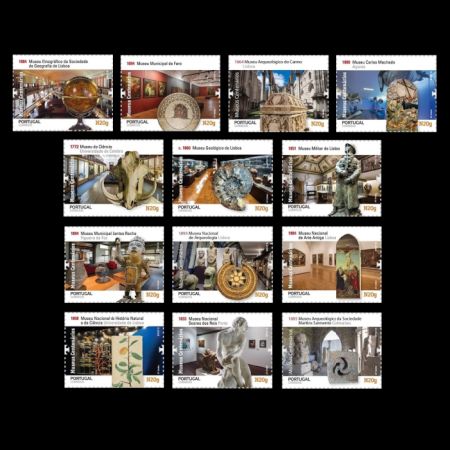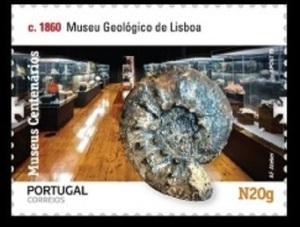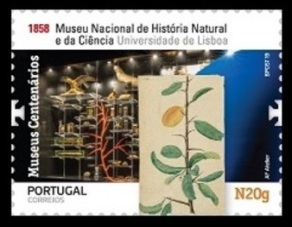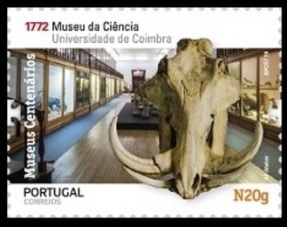| Issue Date | 05.04.20019 |
| ID | Michel: Scott: Stanley Gibbons: Yvert: UPU: N/A Category: pR |
| Author | Design: AF Atelier Photo: Manuel Aguiar, Carlos Monteiro |
| Stamps in set | 13 |
| Value | 13 x N20g rate (domestic letter rate for letter up to 20gr.)
|
| Size (width x height) | 40x30,6 mm |
| Layout | Sheets of 52 copies with 13 stripes of 4 stamps each (1 stripe for each Museum). |
| Products | FDC x2 Presentation Pack x1 |
| Paper | FSC 110g/m2 |
| Perforation | 12x12 |
| Print Technique | Offset |
| Printed by | bpost Philately & Stamps Printing |
| Quantity | 100.000 x13 |
| Issuing Authority | CTT Correios de Portugal |

On April 5 of 2019 Post Authority of Portugal introduced a set of 13 stamps "CENTENNARY MUSEUMS OF PORTUGAL". Every stamp is dedicated to different museum of the country.
"This stamp issue is an integral part of a work dedicated to Portuguese museological heritage, the first volume of which is now coming to light. True guardians of memory, the thirteen century-old museums that are presented here were all founded between 1772 and 1894, in a period marked by extraordinary advances, having each one of them its own story to tell. A unique story that distinguishes it from all others. A story of resilience marked by the will to thrive in often adverse circumstances, and which made them repeatedly reinvent themselves up to the present day. Distributed throughout the national territory, on the mainland and on the islands, from the coast to the interior, these century-old museums, both public and private, act as bridges between the monuments, places and communities that form them.
Dating to 1772, the Natural History Cabinet of the University of Coimbra – today the Museum of Science – is the oldest living museum in Portugal. It is the heir to the country's first scientific collections, gathered by Domingos Vandelli in the Royal Museum and Botanical Garden of Ajuda, which was founded in 1768 at the behest of the Marquis of Pombal.
Six decades later, even amidst the siege of Porto, King Pedro IV created the Museu Portuense, now the Soares dos Reis National 1833, it was the country's frst public art museum. In 1851, the Artillery Museum – today the Military Museum – was opened in the facilities of the former Royal the importance of this military institution in a century marked by liberal
struggles.
In 1858, now Museum of Natural History of Science of Lisbon - MUHNAC – was established in the building of the Royal Nobles, later the Polytechnic School.
Around 1860, the Lisbon Geological Museum was opened on the first floor of the Academy of Sciences building in the heart of Bairro Alto, housing the most complete geological collection of the country.
In 1864, the Archaeological Museum of Carmo was founded within the Royal Association of Portuguese Civil Architects and Archaeologists, to whom King Luís ceded the management of a convent erected in the 14 by Nun'Álvares Pereira to mark the victory of Aljubarrota. Focussed on Natural History, the Azorean Museum – today the Carlos Machado Museum – appeared in 1880 on the island of São Miguel in the Azores. Based in the Santo André Convent in Ponta Delgada, it quickly expanded its collections.
In 1884, the Historical and Ethnographic Museum was founded by the Lisbon Geographical Society. Now the Ethnographic Museum of the Lisbon Geographical Society, it tells the story of the Portuguese presence in Africa, India, Macao and Timor. Following the Ornamental Art Exhibition that had taken place in Lisbon that same year, the Museum of Fine Arts and Archaeology was created, today the National Museum of Ancient Art. Months later in 1885, the Martins Sarmento Society, an illustrious cultural institution in Guimarães, opened the doors of its Archaeological Museum.
Eight years later, in 1893, José Leite de Vasconcellos founded his Ethnographic Museum, currently the National Museum of Archaeology. Today, around 380 thousand pieces make up its collections, which cover a vast chronological spectrum of almost half a million years.
A year later in 1894, the country witnessed the birth of the Archaeological and Lapidary Museum of Faro, currently the Municipal Museum of Faro, a guardian of the heritage of this city of the Algarve from Roman times to today. Also in that year, the Municipal Museum of Figueira da Foz – now the Santos Rocha Municipal Museum – was created, dedicated to the study of the various branches of human sciences. Each of these museums carries a living and dynamic legacy which gives rise to new readings every day. A heritage condensed here in twenty-six images and spanning more than a century of history." [R1]
Cristina Cordeiro
Author of the book Museus Centenários de Portugal
(Centennary Museums of Portugal)
Author of the book Museus Centenários de Portugal
(Centennary Museums of Portugal)
There are 3 stamps of interest for Paleontology stamp collectors:
Museu Geológico de Lisboa Fossil of Ammonite of genus Euaspidoceras from Upper Jurassic time (50 million years ago), found in Malhão, Loulé, shown on front of "Museu Geológico de Lisboa" stamp Fossil of Ammonite of genus Euaspidoceras from Upper Jurassic time (50 million years ago), found in Malhão, Loulé, shown on front of "Museu Geológico de Lisboa" stampThe Geological Museum is located on the 2nd floor of the building of the old Convent of Nossa Senhora de Jesus of the Order Terceira de S. Francisco, in the heart of the historical center of Lisbon, near Bairro Alto. The arrangement of collections, his furniture and interior design exhibition reflect, the XIX century type of museology, one of few that remain in Europe, which makes it be regarded by experts as a "Museum of Museums". One room of the museum is "Paleontology and Stratigraphy Room". This room occupies the largest area of the museum, isolated or in central displays cases are exhibited more than 2200 specimens of fossils from all ages with representation in Portugal. [R2] |
Museu Nacional de História Natural e da Ciência, Universidade de Lisboa The
MUHNAC / Museums of the University of Lisbon aims to promote curiosity
and public understanding of nature and science, bringing the University
closer to Society. This mission is achieved through the valorization of
its collections and the university heritage, research, organization of
exhibitions, conferences and other scientific, educational, cultural
and leisure activities. The
MUHNAC / Museums of the University of Lisbon aims to promote curiosity
and public understanding of nature and science, bringing the University
closer to Society. This mission is achieved through the valorization of
its collections and the university heritage, research, organization of
exhibitions, conferences and other scientific, educational, cultural
and leisure activities.The Museum supports research and teaching in the fields of zoology and anthropology, botany, mineralogy, geology, paleontology, and other natural sciences Mineralogy, Geology and Paleontology Department preserves and enhances the museum's mineralogy, geology and paleontology collections, promoting its use in advanced research and training, and in educational activities and the diffusion of scientific culture. |
Museu da Ciência da Universidade de Coimbra xxxx xxxx |
| FDC | Circulated covers |
| Brochure | |
|
|
|
References:
[R1] Information brochure of Portuguese Post (CTT)
[R2] Geological Museum
[R3] Ulisboa.pt Museus.ulisboa.pt
 |
|
Last update 24.11.2017
Any feedback, comments or even complaints are welcome: [email protected] (you can email me on ENglish, DEutsch, or RUssian)